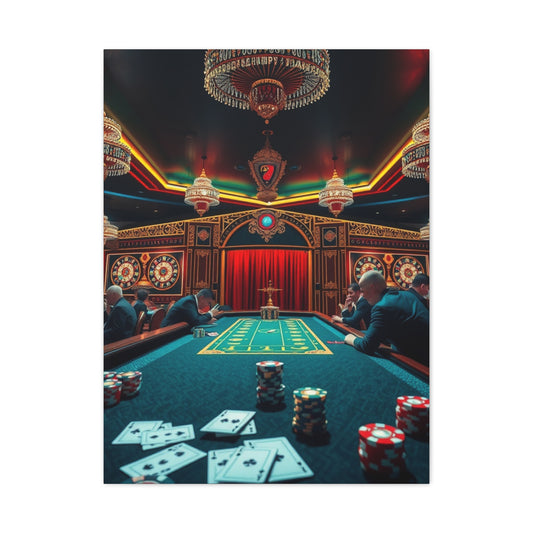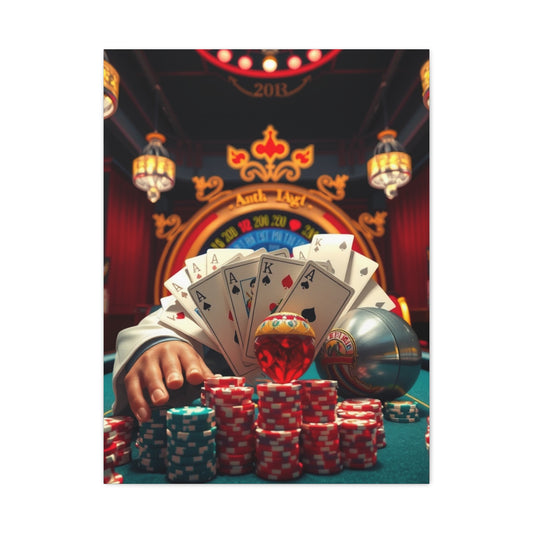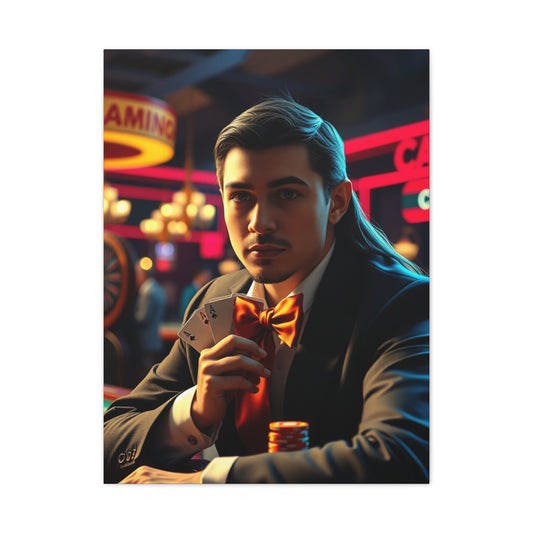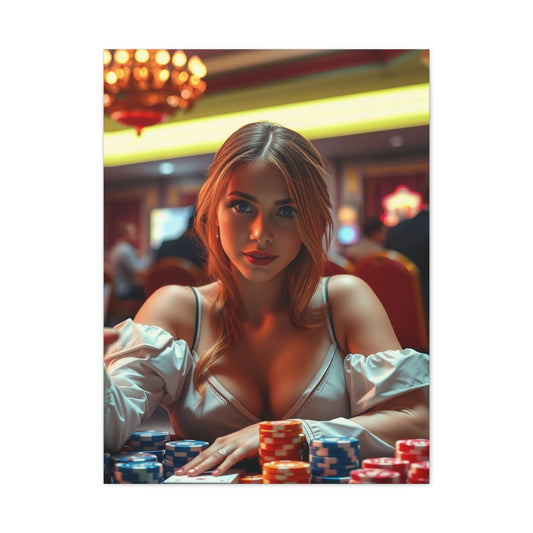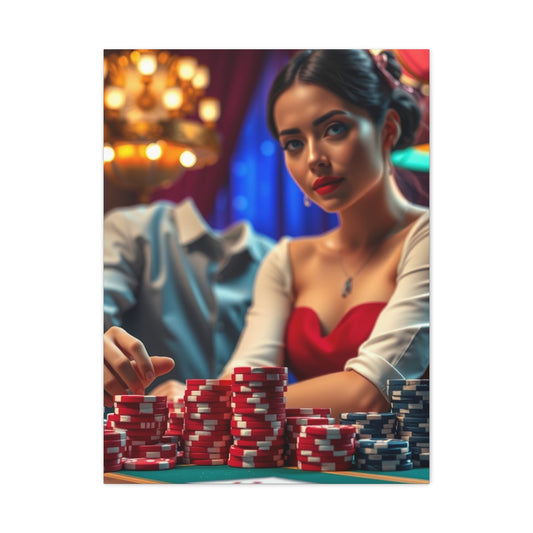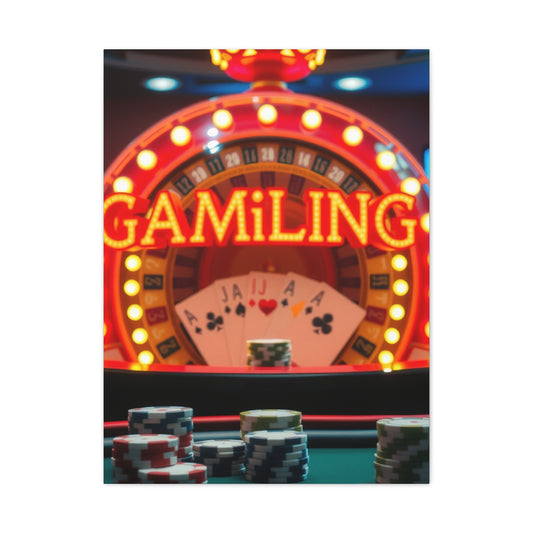Elevate Your Space with Gambling Wall Art and Poker-Inspired Designs
Poker has long carried an aura of mystique, blending chance, skill, and psychological mastery into one of the most enduring pastimes in human history. Beyond the strategies and wagers, the imagery associated with the game has woven itself into culture, art, and design. Among the most striking of these motifs are the playing cards themselves, with their unique blend of symbolism, artistry, and historical depth. When translated into wall art, these designs elevate a room with sophistication, nostalgia, and character. This exploration delves into the artistry of playing card visuals and how they can be incorporated into classic poker-inspired décor.
The Timeless Appeal of Playing Card Imagery
Playing cards have been cherished not only as tools for gaming but also as miniature canvases for artistry. Their origins stretch back centuries, with variations appearing across continents, each culture layering new meanings into the suits, symbols, and face cards. In poker-themed wall art, these timeless icons remain at the forefront, captivating the eye with their balance of simplicity and intricacy.
The King, Queen, and Jack stand as familiar archetypes, and yet their presentation across history has shifted dramatically. Medieval European decks often depicted monarchs with specific regalia, while modern versions favor stylized, symmetrical designs. Displayed as framed prints, these face cards offer a classic yet adaptable choice for décor, reflecting both heritage and aesthetic refinement. Their ability to act as focal points makes them ideal for a game room, where visual cues of authority and elegance enhance the overall atmosphere.
Framing the Royal Court of Cards
When imagining poker wall art, few motifs carry the same gravity as the royal court cards. Framed artwork featuring the King, Queen, and Jack can be presented in numerous ways, each producing a distinct effect. A minimalist approach might emphasize a stark black-and-white rendering, creating a modern contrast suitable for contemporary spaces. Alternatively, vibrantly colored depictions with ornate detailing harken back to the grandeur of early European designs.
These framed pieces can be arranged as a triptych, aligning the three figures side by side to symbolize hierarchy and unity. Alternatively, a larger singular image—such as the King of Spades—can dominate the wall, commanding attention with its dramatic presence. Such arrangements speak not only to poker enthusiasts but also to admirers of symbolic art, where the figures represent strength, strategy, and allure.
The Symbolic Resonance of Suits
Beyond the royal figures, the four suits—spades, hearts, diamonds, and clubs—carry their own resonant symbolism. Historically, suits were often associated with elements of life: spades representing nobility and military, hearts symbolizing the clergy or love, diamonds reflecting wealth, and clubs indicating agriculture or labor. These symbolic dimensions provide fertile ground for artistic exploration, especially when incorporated into wall art that blends history with poker culture.
Decorative canvases featuring enlarged suits can make bold statements. A single oversized heart rendered in a brushstroke-inspired design evokes warmth and emotional energy, while a spade in stark black communicates intensity and gravitas. When displayed in pairs or sets, these symbols transform into visual poetry, adding rhythm and harmony to a game room or lounge. Their abstract nature also lends them to creative reinterpretations, blending easily into both modern and classic interiors.
The Allure of Minimalist Card Art
While some enjoy ornate renderings, minimalist playing card art has grown increasingly popular. Stripped of extraneous detail, a simple outline of a card or a monochrome depiction of a suit communicates elegance and restraint. Minimalist poker-themed wall art often relies on negative space, allowing the subject to breathe within the composition.
This approach suits those who prefer understated décor, where subtle nods to poker emerge without overwhelming the space. Imagine a matte canvas with only the faint outline of the Ace of Spades, its understated design suggesting mystery while maintaining sophistication. Minimalist interpretations allow the essence of poker to shine without ostentation, blending seamlessly into environments that prioritize calm, balance, and clean design.
Historical Playing Cards as Artistic Inspiration
Antique card decks offer an extraordinary source of inspiration for wall art. Early European cards often bore hand-painted illustrations, each unique in its artistry. These decks reveal not only the evolution of poker but also the broader cultural and aesthetic trends of their time. Reproductions or prints inspired by these antique designs make for captivating décor pieces that blend nostalgia with artistry.
Incorporating historical card artwork into a room can imbue it with character and narrative. For instance, reproductions of sixteenth-century French decks often feature intricately drawn face cards with symbolic details tied to monarchs and mythological figures. Displaying these in frames or canvases provides a conversation piece while also reinforcing the timeless heritage of poker as both a game and cultural artifact.
Triptychs and Series in Poker Décor
One of the most effective ways to showcase poker-inspired playing card art is through series or triptychs. Rather than a solitary piece, a sequence of coordinated artworks creates rhythm and visual progression across a wall. Imagine three aligned canvases featuring the King, Queen, and Jack of Hearts, their expressions unified by a consistent design style.
This arrangement not only emphasizes the hierarchy within the card deck but also enhances the architectural flow of the room. Series-based art also lends itself to thematic storytelling, with each canvas acting as a chapter in a broader narrative. Such arrangements thrive in game rooms where dynamism and storytelling are central to the atmosphere.
Playing Card Murals for Impactful Presence
For those seeking bold visual statements, murals inspired by poker cards transform entire walls into artistic landscapes. Unlike framed prints, murals immerse the viewer in the imagery, creating an environment steeped in the culture of cards. A mural of a colossal Ace of Spades, rendered in detailed strokes or even graffiti-inspired style, can dominate a space with dramatic flair.
Murals allow for creativity in scale and detail, enabling designs that feel immersive and commanding. They often blur the line between wall art and interior architecture, embedding poker’s visual language directly into the structure of the room. Game rooms with such murals often achieve an unforgettable atmosphere, where the essence of poker resonates in every corner.
Color Palettes in Poker-Themed Art
Color plays a decisive role in how poker-inspired wall art influences a room. Traditional card colors—red, black, and white—carry sharp contrasts that naturally attract the eye. When incorporated into décor, these hues provide clarity and energy.
However, more nuanced palettes can produce intriguing results. Sepia tones evoke the feeling of aged playing cards, invoking nostalgia and warmth. Metallic accents, such as gold and silver, can elevate a piece with a regal quality, aligning with the prestige often associated with the game. Meanwhile, subdued palettes—such as muted grays or pastel interpretations—reimagine poker themes with modern sensibilities, offering fresh perspectives on a timeless subject.
Balancing Sophistication and Playfulness
Poker-themed décor walks a delicate line between sophistication and playfulness. On one hand, the game is linked to calculated strategy, tension, and the allure of chance. On the other hand, it embodies social interaction, levity, and amusement. Playing card wall art can be curated to reflect either side of this duality, depending on the desired ambiance.
Sophisticated interpretations might emphasize ornate detailing, subdued tones, and symmetrical designs, highlighting the intellectual allure of the game. Playful renditions, by contrast, may employ vibrant colors, whimsical illustrations, or stylized caricatures of card characters, underscoring the convivial and entertaining aspects of poker. This versatility makes playing card art suitable for a wide range of interiors, from formal lounges to casual game rooms.
Integrating Playing Card Art into Diverse Interiors
Poker-inspired wall art is not confined to game rooms alone. Its adaptability allows it to enrich various types of interiors, from modern apartments to traditional homes. In a sleek urban loft, minimalist card outlines in monochrome may blend effortlessly with industrial materials like steel and concrete. In a rustic cabin retreat, antique card reproductions framed in wood harmonize with natural textures, creating warmth and nostalgia.
Even within professional settings such as offices or lounges, poker-themed art can strike a balance between playfulness and sophistication. Its universality and symbolic resonance enable it to transcend the boundaries of recreational décor, finding relevance wherever storytelling and symbolism are valued.
Crafting Atmosphere Through Poker Art
Beyond visual aesthetics, poker-themed wall art contributes significantly to the atmosphere of a space. A framed Ace of Spades does more than decorate—it conveys authority, mystery, and challenge. A mural of card suits splashed across a wall generates energy and excitement, setting the stage for gatherings.
Atmosphere is often intangible, yet it defines the emotional resonance of a room. Playing card art, with its combination of historical weight and cultural symbolism, acts as a catalyst for atmosphere. Whether the goal is gravitas, levity, or elegance, these motifs offer the versatility to achieve the intended emotional effect.
Vintage Casino Posters and Nostalgic Poker-Inspired Aesthetics
The world of poker carries an undeniable air of nostalgia, one that conjures images of smoky casinos, dimly lit card tables, and the exhilarating hum of voices and chips. Among the most evocative ways to capture this atmosphere in a decorative setting is through vintage casino posters and poker-inspired artwork rooted in retro aesthetics. These designs do more than decorate; they transport the viewer to a bygone era of glamour and risk, where the game was as much about spectacle as it was about strategy. By incorporating these motifs into wall décor, a room becomes a stage upon which the drama and allure of poker unfold in timeless fashion.
The Golden Age of Casino Culture
The twentieth century brought with it a golden age of casinos, particularly in places like Las Vegas, Reno, Monte Carlo, and Havana. Each destination cultivated its own distinctive atmosphere, often immortalized in posters and advertising artwork. These posters were not merely promotional tools but artifacts of design, showcasing typography, illustration, and color palettes that now resonate with nostalgic charm.
Las Vegas posters often embraced bold typography, neon hues, and exaggerated imagery that mirrored the city’s reputation for spectacle. In contrast, Monte Carlo designs favored elegance, with ornate lettering and sophisticated illustrations emphasizing refinement. For poker enthusiasts, these posters capture the environments in which the game was not simply played but celebrated as a cultural phenomenon. Hanging such art in a game room or lounge offers a portal back to these vibrant locales.
Design Elements in Vintage Casino Posters
The appeal of vintage casino posters lies not only in their imagery but also in the specific design elements that make them timeless. Typography plays a central role, with fonts ranging from sweeping Art Deco scripts to sharp mid-century block letters. These letterforms create rhythm and energy, pulling the eye across the composition with a sense of urgency and style.
Illustrations often depicted scenes of gaming tables, roulette wheels, or poker hands frozen in suspense. Characters were painted with exaggerated features, sometimes caricatured to heighten the sense of excitement or allure. The color palettes tended toward contrasts—deep reds paired with gold, emerald greens against black backgrounds, or vibrant yellows balanced with muted tones. These elements combined to create not just advertisements but works of art that now serve as cultural touchstones.
Nostalgia as a Decorative Force
Nostalgia is a powerful force in design, evoking memories and emotions tied to earlier times. For poker-inspired décor, vintage posters tap into this sentiment by recreating the environments in which the game flourished historically. A framed reproduction of a 1950s Las Vegas poster, with its playful illustrations and lively typography, instantly transforms a modern room into a space alive with retro energy.
In game rooms, nostalgia enhances atmosphere by connecting the present with the legacy of poker’s past. Guests may not have experienced the grandeur of a Monte Carlo casino in the 1930s, yet the imagery evokes a sense of shared history and cultural memory. This blending of personal imagination with collective nostalgia makes vintage posters uniquely effective as wall art.
Iconic Motifs in Retro Poker Artwork
Several motifs recur throughout vintage poker and casino posters, each carrying its own resonance. Card hands depicted mid-play evoke tension and anticipation. Poker chips stacked high on a felt table convey stakes and risk. Glamorous figures dressed in evening wear emphasize the social prestige of casino gaming.
Some posters focus specifically on poker, illustrating the iconic royal flush or the suspenseful reveal of a hidden card. Others place poker within the broader tapestry of casino culture, showing tables alive with roulette, baccarat, and blackjack alongside card games. These motifs are not simply decorative; they narrate the drama inherent in games of chance, where fortunes shift with the turn of a card.
Incorporating Vintage Posters into Game Rooms
Incorporating vintage casino posters into a game room requires attention to placement, framing, and balance. A large poster positioned as the centerpiece of a wall creates a focal point that sets the tone for the room. Smaller posters arranged in a gallery-style layout bring variety and rhythm, guiding the viewer’s gaze from one piece to the next.
Framing choices further enhance the effect. A sleek black frame emphasizes modernity, allowing the vintage imagery to stand out against its backdrop. Ornate gold or wooden frames, on the other hand, accentuate the retro quality, making the poster feel like a treasured relic from a glamorous past. Lighting also plays a crucial role, with spotlights or backlighting elevating the visual impact of the artwork.
Evoking Atmosphere Through Color and Tone
Vintage posters often carry distinctive color schemes that influence the atmosphere of a room. Bright neon tones evoke energy and exuberance, suitable for lively gaming areas. More subdued palettes, such as sepia-toned reproductions, create a moodier ambiance reminiscent of private clubs or speakeasies. By selecting posters with specific tonal qualities, one can shape the overall mood of the environment.
A poster dominated by reds and golds might heighten a sense of intensity and opulence, while a piece rendered in cool blues and greens introduces calm sophistication. Blending multiple posters with complementary palettes allows for dynamic yet harmonious décor, where each piece contributes to the room’s larger visual story.
Rare Collectibles as Decorative Anchors
While reproductions capture the spirit of vintage casino posters, authentic originals carry an additional layer of significance. These rare collectibles often show signs of aging—faded colors, worn edges, or delicate paper textures—that add authenticity and character. Owning and displaying such a piece transforms a room into a space where history and décor converge.
Even when originals are inaccessible, high-quality reproductions can be customized to simulate vintage wear. Faux aging techniques, such as distressed textures or muted color applications, create the impression of historical depth. Whether authentic or reproduced, these posters serve as decorative anchors, grounding a room in the cultural legacy of poker and casino life.
The Intersection of Art Deco and Casino Design
The influence of Art Deco on casino culture is particularly striking, and many vintage posters showcase its hallmarks. Geometric shapes, symmetrical layouts, and metallic accents define this aesthetic, aligning perfectly with the atmosphere of elegance and spectacle that poker thrives upon. Incorporating Art Deco-inspired posters into décor reinforces a sense of sophistication and grandeur.
For example, an Art Deco poster of a Monte Carlo casino featuring sleek architectural lines and stylized figures instantly communicates glamour and precision. When paired with poker-themed furnishings or lighting, the space takes on the feel of a classic lounge where every detail contributes to a cohesive narrative of refinement.
Storytelling Through Poster Art
One of the unique powers of vintage casino posters lies in their ability to tell stories. Unlike minimalist art or abstract compositions, posters often include multiple visual elements that interact to form a narrative. A woman in a glittering gown leaning over a card table, a dealer frozen mid-deal, or a dramatic spotlight illuminating a tense poker hand all contribute to cinematic storytelling.
By placing such posters in a room, one does more than decorate—it creates an ongoing narrative that guests engage with. The room becomes alive with implied scenes of chance, victory, and suspense. This storytelling quality distinguishes vintage posters from other forms of poker décor, offering depth and intrigue beyond surface beauty.
Balancing Nostalgia with Contemporary Design
While vintage posters thrive on nostalgia, they can also be integrated into contemporary interiors with thoughtful balance. In modern minimalist spaces, a single vibrant retro poster provides contrast and focal interest. In eclectic settings, multiple posters can be combined with other vintage-inspired elements—such as antique furniture, retro lighting, or patterned textiles—to create immersive environments.
The key is balance: too many nostalgic elements may overwhelm, while a carefully chosen poster acts as a bridge between the past and present. This versatility makes vintage casino posters a valuable design choice, capable of enriching diverse interiors without clashing with existing styles.
Beyond Game Rooms: Expanding Vintage Aesthetics
Although most commonly associated with game rooms, vintage casino posters extend their charm to other spaces as well. In a study or library, a framed poker-themed poster evokes intellectual curiosity and history. In a lounge or bar area, it sets a mood of conviviality and sophistication. Even in hallways or transitional spaces, smaller reproductions create visual interest and hint at the personality of the household.
This adaptability ensures that poker enthusiasts can incorporate vintage aesthetics throughout their home, not just in areas directly tied to gaming. Each placement carries its own nuance, shaping the mood of the space while maintaining thematic coherence.
The Emotional Resonance of Nostalgic Décor
Ultimately, the appeal of vintage casino posters lies in their emotional resonance. They capture not only the imagery of poker and casinos but also the emotions tied to those worlds—anticipation, glamour, camaraderie, and risk. Displayed in a room, they invite viewers to step into those emotions, creating environments where imagination and memory intertwine.
By cultivating this resonance, poker-themed décor transcends mere ornamentation. It becomes experiential, encouraging people to feel the drama of the game and the romance of its history. Vintage posters achieve this uniquely, bridging past and present while enriching the atmosphere with cultural and artistic depth.
Modern Interpretations: Abstract Poker Art and Contemporary Expression
Poker may be rooted in centuries-old traditions, yet its visual language continues to evolve. While classic playing card motifs and vintage casino posters honor the heritage of the game, contemporary interpretations embrace abstraction, minimalism, and experimental design. Abstract poker art, in particular, offers a fresh perspective that emphasizes mood, energy, and symbolism rather than literal imagery. By introducing modern aesthetics into poker-inspired décor, spaces can achieve a unique character that balances heritage with innovation.
The Essence of Abstraction in Poker Art
Abstraction in art distills subjects into their most fundamental forms. Instead of depicting a poker hand with detailed accuracy, abstract artwork might emphasize shapes, colors, and textures that evoke the sensation of risk, strategy, or anticipation. A swirling arrangement of red and black strokes may symbolize the clash of hearts and spades, while geometric forms suggest the logic and calculation underlying the game.
The allure of abstraction lies in its open-endedness. Unlike literal depictions of playing cards or casinos, abstract poker art allows viewers to interpret meaning in personal ways. For some, it may conjure memories of tense games with friends; for others, it might represent the unpredictability of chance itself. This interpretive quality makes abstract works highly versatile for interiors that value individuality and atmosphere.
Modern Materials and Techniques
Contemporary poker art often employs innovative materials and methods that distinguish it from traditional pieces. Acrylic paints, metallic foils, and digital prints on canvas allow for striking textures and reflective qualities. Mixed-media approaches, where poker chips or fragments of playing cards are integrated into collages, create tactile and layered compositions that blur the line between painting and sculpture.
Digital art has further expanded the boundaries of poker-themed imagery. Designers can create sleek vector-based graphics or surreal digital collages that reinterpret familiar symbols in unexpected contexts. These works can be printed on high-resolution canvases, wallpapers, or even illuminated panels, offering immersive possibilities for game rooms and lounges.
Geometric Interpretations of Poker Symbols
Geometry plays a central role in many modern interpretations of poker art. The suits themselves—spades, hearts, diamonds, and clubs—lend themselves to abstraction through repeated patterns, tessellations, or minimalist outlines. A composition featuring a grid of simplified spades, each slightly altered in shape or tone, transforms the familiar symbol into a rhythmic study of variation.
Geometric abstraction also allows for dynamic juxtapositions of form. Diamonds can be reframed as prisms or crystalline structures, their angularity suggesting precision and value. Clubs may be reimagined as organic silhouettes echoing botanical motifs. Through geometry, poker’s traditional symbols gain renewed vitality, aligning with the aesthetics of modern design while maintaining their cultural resonance.
Color as Atmosphere in Contemporary Art
Color is perhaps the most powerful tool in abstract poker art, shaping not only the composition but also the mood of the surrounding space. Red and black, the traditional hues of playing cards, continue to dominate, symbolizing intensity, passion, and contrast. Yet modern artists often experiment with expanded palettes—electric blues, metallic silvers, or even muted pastels—to challenge expectations and introduce fresh emotional layers.
A monochrome canvas depicting an abstract Ace of Spades in shades of gray communicates restraint and gravitas. In contrast, a vibrant multicolor piece filled with angular bursts may convey the thrill and unpredictability of poker nights. By selecting artworks with deliberate color schemes, one can influence the emotional tenor of a room, making it contemplative, energetic, or playful depending on the desired effect.
Minimalism and the Art of Suggestion
Minimalist poker art strips imagery down to its essence, often relying on suggestion rather than explicit representation. A canvas with nothing but a thin white outline of a playing card on a black background embodies both elegance and mystery. Such works thrive in contemporary interiors that prioritize clean lines and uncluttered spaces.
Minimalism resonates particularly well in poker-inspired décor because the game itself often hinges on subtle cues and unspoken signals. Just as a player’s expression might reveal or conceal intention, minimalist art suggests without declaring. This alignment of theme and form makes minimalist interpretations especially meaningful for poker enthusiasts who appreciate subtlety and restraint.
Abstract Expressionism and the Energy of Poker
Abstract expressionist approaches to poker art emphasize gesture, spontaneity, and emotional intensity. Swathes of paint applied in vigorous strokes can symbolize the volatility of the game, where fortunes swing unpredictably. Splattered reds and layered blacks may represent the raw intensity of betting rounds, while lighter accents hint at fleeting moments of triumph.
This style aligns with poker’s psychological drama, where tension and release play out in cycles. Displayed in a game room, expressionist poker art adds dynamism and movement, energizing the environment and sparking conversations. Its rawness contrasts with the structured formality of traditional playing card art, offering an unfiltered reflection of the emotions poker evokes.
Contemporary Typography in Poker Décor
While classic posters often relied on ornate or retro lettering, modern poker art experiments with contemporary typography. Clean sans-serif fonts, oversized letters, or fragmented text arrangements bring a fresh sensibility to poker-related quotes and phrases. Typography-based pieces can emphasize wit, strategy, or philosophy, while their modern presentation situates poker firmly within the aesthetics of the present day.
For instance, a stark black canvas emblazoned with the word “BLUFF” in minimalist white text carries both visual power and thematic resonance. Such works combine verbal and visual impact, engaging viewers intellectually and emotionally. Typography in modern poker décor demonstrates how language itself can become a form of abstraction, shaping atmosphere as effectively as imagery.
The Role of Light in Contemporary Poker Art
Modern interpretations increasingly experiment with illumination as part of the artwork. Neon signs in the shape of spades or glowing quotes about poker infuse a room with both color and ambiance. LED-lit canvases that backlight abstract compositions create depth and immersive presence, turning static pieces into dynamic features.
Light-based art aligns naturally with poker’s heritage in casinos, where glowing signs and ambient lighting defined atmosphere. In contemporary homes, these illuminated pieces merge nostalgia with modernity, offering innovative ways to honor the game while embracing current design trends.
Large-Scale Installations and Immersive Design
Abstract poker art need not be confined to framed pieces. Large-scale installations and immersive designs push boundaries, transforming entire walls into poker-inspired environments. Murals featuring fragmented card symbols or flowing abstract patterns create a sense of motion and energy. Wallpaper designs based on repeated minimalist motifs introduce subtle yet pervasive references to poker throughout a space.
Sculptural installations also offer intriguing possibilities. Suspended geometric forms inspired by poker suits or three-dimensional wall-mounted designs crafted from acrylic or metal infuse rooms with tactile and spatial interest. Such installations emphasize that poker’s artistic influence extends beyond flat surfaces, encompassing entire environments that embody the spirit of the game.
Abstract Narratives in Poker Art
While abstraction often avoids literal storytelling, many contemporary works still weave narratives through symbolic forms. A composition of layered circles and triangles may allude to the cycles of luck and calculation in poker. Fragmented shapes overlapping chaotically might evoke the mental turbulence of decision-making under pressure. Through such symbolic abstraction, poker art captures not just the imagery but also the psychology of the game.
Narrative abstraction allows décor to function on multiple levels, offering visual intrigue for casual observers while rewarding deeper reflection for those who engage with the work. In this way, poker-inspired abstraction becomes not only a decorative element but also a philosophical exploration of chance, strategy, and human behavior.
Integrating Abstract Poker Art into Modern Interiors
Abstract poker art integrates seamlessly into modern interiors, where clean lines and open spaces provide ideal backdrops for bold compositions. In minimalist settings, a single large abstract piece can command attention without overwhelming the environment. In eclectic interiors, multiple abstract works can be combined to create layered narratives and visual dynamism.
The adaptability of abstract art allows it to complement diverse styles. A sleek black-and-white geometric canvas fits within industrial lofts, while colorful expressionist pieces harmonize with bohemian interiors. Poker’s visual symbols, distilled into abstraction, act as bridges between tradition and innovation, ensuring relevance across a wide spectrum of design approaches.
Emotional Impact of Contemporary Expressions
Abstract and modern poker art does more than innovate visually—it shapes the emotional resonance of a room. The unpredictability of bold strokes mirrors the suspense of waiting for a card. The tranquility of minimalist outlines reflects the quiet focus of strategic play. The radiance of illuminated works recalls the vibrancy of casinos while adapting it for domestic spaces.
This emotional versatility ensures that abstract poker décor resonates with diverse audiences. Whether aiming for excitement, sophistication, contemplation, or nostalgia reframed through modern design, contemporary interpretations provide the means to achieve it. Poker art, once bound to literal imagery, now flourishes as a medium of emotional expression and atmospheric design.
Personalized Poker Wall Art and the Beauty of Custom Creations
Poker is more than a game; it is a personal journey shaped by strategy, experience, and moments of triumph or defeat. This intimate connection makes personalized poker wall art especially compelling, transforming spaces into reflections of individual passion and style. Custom creations allow enthusiasts to move beyond generic designs, imbuing their environment with meaning, narrative, and artistry that is uniquely theirs. Through thoughtful curation, commissioned pieces, and bespoke design, poker-themed décor can achieve a level of distinction unmatched by mass-produced alternatives.
The Appeal of Personalized Art
Personalized poker art resonates on multiple levels. It represents not just an aesthetic choice, but a celebration of personal experiences, favorite hands, or memorable games. Unlike generic reproductions, commissioned or customized artwork carries emotional weight, creating a tangible link between the observer and the game.
A custom painting depicting a specific winning hand, for instance, immortalizes a moment of achievement. Similarly, an abstract work designed to evoke the atmosphere of a favorite poker night captures the unique energy of that event. In both cases, the artwork transcends decoration, becoming a repository of memory, pride, and identity.
Commissioning Artwork for Individual Expression
One of the most compelling ways to incorporate personalized poker wall art is through commissioned pieces. Artists can interpret a player’s vision, translating abstract ideas, stories, or favorite moments into visual form. Commissioned works offer limitless possibilities: traditional oil paintings, digital illustrations, mixed-media collages, or even sculptural pieces.
The collaborative nature of commissioned art ensures that each piece is imbued with intention. Artists can adapt color palettes, symbolism, and scale to suit both the space and the individual’s tastes. This process results in art that is not only aesthetically striking but also deeply meaningful, reflecting the player’s connection to poker in ways that pre-made pieces cannot replicate.
Incorporating Personal Poker Memorabilia
Beyond commissioned artwork, personal memorabilia can be integrated into wall art to create unique displays. Framing poker chips collected from various games, tickets from tournaments, or photographs of memorable moments elevates these objects from keepsakes to curated art. Shadow boxes, custom frames, or acrylic encasements protect and present these items in a visually engaging way.
This approach allows décor to become both decorative and narrative-driven. Guests are invited to engage with the story behind each item, while the room itself reflects a lifetime of experiences and accomplishments. The juxtaposition of physical memorabilia with artistic representation adds depth, texture, and authenticity to poker-inspired spaces.
Custom Canvas Prints and Digital Interpretations
Modern technology has expanded the possibilities for personalized poker art. High-resolution digital images can be transformed into canvas prints, providing clarity, vibrancy, and durability. Players can submit photographs, design concepts, or sketches, which artists or digital designers can enhance into striking compositions.
Digital processes also allow for experimentation with effects, textures, and layouts that might be challenging in traditional media. Metallic finishes, layered transparencies, and gradient overlays create dynamic visuals that engage viewers and transform ordinary walls into immersive experiences. By leveraging digital techniques, personalized poker art achieves a blend of innovation and tradition.
The Role of Typography in Custom Poker Pieces
Typography plays a significant role in personalized poker wall art, particularly for those seeking to incorporate favorite quotes, tournament mottos, or memorable sayings. Customized text-based art can balance visual aesthetics with meaning, emphasizing strategy, wit, or philosophy related to poker.
Modern typography techniques allow artists to manipulate scale, spacing, and orientation to produce dramatic effects. Words may interact with imagery, wrapping around card symbols or following abstract lines to create movement. This integration ensures that the verbal and visual components of the piece reinforce one another, resulting in a cohesive and engaging work of art.
Hand-Painted and Mixed-Media Creations
For those seeking tactile richness, hand-painted and mixed-media works offer unparalleled depth and texture. Layers of acrylic, oil, or watercolor can capture the subtle nuances of poker scenes, while the addition of poker chips, metallic foil, or textured paper introduces dimensionality.
Mixed-media approaches allow artists to explore contrast and interaction between materials. A painted background of a felt poker table might be combined with real chips affixed to the surface, creating a hybrid piece that is part painting, part sculpture. Such works demand attention and provoke curiosity, transforming ordinary walls into focal points rich with detail and intrigue.
Personalized Themes and Visual Storytelling
Custom poker art also excels in narrative potential. A series of paintings depicting the evolution of a player’s journey, from casual home games to competitive tournaments, transforms a room into a living story. Abstract pieces may capture the psychological tension, anticipation, and exhilaration inherent in poker, while figurative works depict gestures, expressions, or iconic hands.
By curating a thematic series, one can achieve both visual coherence and narrative depth. Each piece contributes to a larger story, allowing viewers to traverse the emotional and strategic landscape of poker as they move through the space. Personalized storytelling ensures that décor is not merely decorative, but immersive, engaging both intellect and emotion.
Integration into Interior Design
Personalized poker art offers versatility in placement and style. Bold, large-scale works dominate focal walls in game rooms, creating energy and drama. Smaller, subtler pieces can complement seating areas, lounges, or private studies, adding personality without overwhelming the space.
Color palette choices, scale, and framing further integrate the artwork with existing interiors. Vibrant, dynamic pieces energize spaces with modern furnishings, while muted, classic tones harmonize with traditional or rustic décor. The personalized nature of these pieces ensures alignment with both aesthetic preferences and functional needs, bridging art with architecture.
Emotional Connection and Longevity
One of the most compelling advantages of personalized poker wall art is its emotional resonance. Unlike generic posters or prints, these creations hold personal significance, often tied to achievements, memorable games, or individual style. This emotional depth fosters a stronger connection to the space, enhancing its comfort, personality, and narrative richness.
Furthermore, personalized artworks possess enduring appeal. As poker enthusiasts evolve in skill and taste, commissioned or custom pieces retain relevance, reflecting not only the individual’s journey but also their evolving aesthetic sensibilities. Unlike trend-driven décor, these works remain timeless, blending personal history with artistry in a lasting fashion.
Collaborating with Artists
Creating a successful custom poker piece often involves close collaboration with artists. Clear communication of vision, mood, and desired elements ensures that the final product aligns with expectations. Artists may offer suggestions on composition, scale, or medium, translating abstract ideas into tangible results while maintaining the client’s intent.
This collaborative process can be rewarding in itself, deepening appreciation for both the artistic process and the game that inspired it. It transforms the act of decorating from a transactional exercise into an experiential journey, where the creation of the artwork mirrors the strategic and creative thinking inherent in poker.
Personalized Poker Art as Conversation Starter
Custom creations naturally serve as conversation starters, particularly in spaces designed for entertainment. Guests are often drawn to the story behind a personalized painting, collage, or mixed-media piece. Discussions may range from the artistic techniques employed to the memorable hands or experiences that inspired the work.
This social dimension enhances the value of personalized art, transforming it from mere decoration into a catalyst for connection. In game rooms or lounges, such pieces contribute to the overall experience, fostering engagement, curiosity, and camaraderie among players and visitors.
Framing and Presentation of Custom Pieces
Presentation plays a vital role in personalized poker wall art. Custom frames can complement the style of the piece, whether through traditional wood, sleek modern metals, or creative shadow boxes. Glass or acrylic coverings protect delicate surfaces, while lighting can highlight textures, metallic accents, or intricate details.
The act of framing and displaying a custom piece adds another layer of intentionality, reinforcing its significance within the space. Proper presentation ensures that the artwork commands attention and resonates with viewers, elevating its impact beyond visual appeal alone.
Expanding Personalized Collections
Personalized poker art can evolve into a curated collection over time. Starting with a single commissioned piece, enthusiasts may gradually expand to include additional works reflecting new experiences, favorite hands, or abstract explorations of strategy. Each addition enriches the narrative, creating a layered and dynamic environment that grows alongside the player’s journey.
This evolving approach allows spaces to remain fresh, meaningful, and visually engaging. Collecting personalized poker art transforms décor into an ongoing project, where each piece contributes to a living tapestry of style, memory, and passion for the game.
Symbolism, History, and Collecting Poker-Themed Wall Art
Poker is more than a game of chance; it is a cultural phenomenon, steeped in history, symbolism, and artistic expression. The imagery surrounding poker—playing cards, chips, casinos, and related motifs—carries layers of meaning that extend beyond mere decoration. Collecting and displaying poker-themed wall art allows enthusiasts to celebrate the rich narrative of the game, blending historical depth, symbolic resonance, and aesthetic appreciation. This exploration delves into the evolution of poker art, its symbolic undertones, and strategies for curating a meaningful collection.
The Historical Evolution of Poker Imagery
Playing cards date back several centuries, originating in China and later spreading through Europe. Early decks were hand-painted, each face card and suit imbued with artistic detail and cultural significance. Over time, playing cards evolved from functional objects into canvases for creative expression, influencing art, literature, and social customs.
The rise of poker as a popular game in the nineteenth and twentieth centuries coincided with the emergence of visual culture surrounding casinos. Artists, illustrators, and designers captured the excitement, glamour, and risk of gambling in prints, posters, and paintings. From sepia-toned illustrations of card rooms to colorful depictions of Las Vegas nightlife, these works document both the history of the game and its social context.
Symbolism in Playing Card Motifs
Poker-themed art is rife with symbolism, much of which originates from the suits and face cards themselves. Spades, for example, are often associated with intellect, strategy, or authority, while hearts symbolize emotion, passion, and social connection. Diamonds frequently represent wealth, prosperity, and material gain, whereas clubs suggest growth, labor, or resilience.
Face cards—Kings, Queens, and Jacks—carry additional layers of meaning. Historically, they were modeled after historical figures, mythological characters, or allegorical representations. When translated into wall art, these cards convey authority, wisdom, or challenge, adding intellectual and cultural depth to a space. Artists frequently reinterpret these symbols, blending historical references with contemporary design to create works that resonate across eras.
Iconography Beyond the Cards
Poker imagery extends beyond playing cards to include chips, tables, dice, and casino architecture. Each element carries symbolic weight: stacked chips evoke stakes, risk, and potential reward; a felt-covered table suggests strategy and social interaction; dice, though less central to poker, imply chance and unpredictability.
These elements can be stylized in artwork to emphasize specific themes. For instance, an abstract painting may feature swirling chips and cards to represent the chaos and excitement of a high-stakes game. Photographic prints of vintage casinos capture elegance and opulence, while digital designs can exaggerate forms to evoke drama and intensity. Collectively, these symbols enrich the narrative potential of poker-themed décor.
Collecting Poker-Themed Wall Art
For enthusiasts, collecting poker art is both a passion and a form of curation. Collectors may focus on specific eras, styles, or artists, building a portfolio that reflects their interests and aesthetic sensibilities. Some prioritize historical accuracy, seeking antique prints or reproductions of nineteenth-century card illustrations. Others embrace modern interpretations, abstract representations, or limited-edition prints that highlight contemporary creativity.
When building a collection, careful consideration of provenance, authenticity, and condition is essential. Original works carry historical and financial value, while reproductions or commissioned pieces offer accessibility and personal relevance. Collecting poker art is not merely an exercise in accumulation; it is a deliberate process of assembling works that resonate emotionally, culturally, and aesthetically.
Integrating Symbolism into Interior Design
Poker-themed wall art offers remarkable versatility in interior design. Symbolic works can act as focal points, guiding the visual narrative of a room. A large painting of an Ace of Spades, for example, communicates authority and intrigue, while a series of abstract chips may energize a contemporary lounge.
Designers can use symbolism strategically, blending poker motifs with color, scale, and lighting to create atmosphere. Warm tones evoke intimacy and nostalgia, metallic accents convey opulence, and bold contrasts suggest drama and tension. Thoughtful placement ensures that the symbolic content enhances both the aesthetic and thematic cohesion of the space.
The Role of Nostalgia in Collecting
Nostalgia plays a central role in poker-themed décor and collection. Vintage posters, sepia-toned illustrations, and retro casino imagery evoke eras when poker was both a pastime and a social spectacle. Displaying these works allows enthusiasts to connect emotionally with the history of the game, preserving cultural memory while enriching the present environment.
Nostalgic works also foster storytelling. Guests can engage with the imagery, imagining the card rooms, tournaments, or home games of decades past. This narrative potential adds depth to interior spaces, transforming walls into portals through which viewers experience the legacy of poker.
Curating a Cohesive Collection
Curating poker-themed art involves more than acquiring pieces; it requires coherence and vision. Collectors may choose a central theme, such as historical poker illustrations, abstract modern interpretations, or vintage casino posters. Within that theme, consistency in color palette, scale, or medium can unify the collection, creating visual harmony across a space.
Alternatively, a diverse collection can showcase contrasts between eras, styles, or materials. Pairing antique prints with contemporary digital works highlights the evolution of poker imagery, while mixing literal depictions with abstract representations encourages dialogue between tradition and innovation. Thoughtful curation ensures that each piece contributes to a cohesive narrative while allowing individual artworks to shine.
Personalization and Storytelling in Collections
Even within curated collections, personalization enhances meaning. Including artworks that reference personal experiences, favorite hands, or notable tournaments transforms décor from generic display to intimate narrative. Commissions, photographs, or memorabilia integrated into framed displays can enrich the collection, adding layers of memory and significance.
This approach emphasizes storytelling as a central aspect of collection-building. Each piece acts as a chapter in a broader narrative, with visual motifs and symbolic elements guiding viewers through the journey. Collectors can therefore craft environments that are simultaneously aesthetic, historical, and deeply personal.
Contemporary Artists and Emerging Styles
The world of poker-themed art continues to evolve as contemporary artists reinterpret classic symbols and motifs. Emerging creators explore digital media, mixed techniques, and experimental approaches, offering fresh perspectives on poker’s visual language. Collectors who embrace contemporary works can diversify their collections while supporting the ongoing development of the genre.
Artists may experiment with surrealism, abstraction, or typographic innovations, reimagining traditional poker imagery in unexpected ways. These works challenge viewers to consider new interpretations of familiar symbols, adding intellectual and emotional depth to spaces where they are displayed. Incorporating contemporary pieces alongside historical works creates dialogue across time, blending nostalgia with innovation.
Preserving and Displaying Poker Art
Proper preservation ensures that poker-themed art maintains its value, integrity, and aesthetic appeal. Archival framing, UV-protective glass, and climate control protect delicate prints, watercolors, and mixed-media works from deterioration. Even digital prints benefit from careful handling and display in controlled environments to prevent fading.
Display choices also affect impact. Central placement, strategic lighting, and complementary décor amplify visual and symbolic resonance. Arranging works in series, triptychs, or gallery-style layouts allows each piece to interact with its neighbors, creating rhythm and narrative flow across the room. The result is an environment that celebrates poker as both art and cultural phenomenon.
Poker Wall Art as Cultural Reflection
Beyond individual enjoyment, poker-themed art reflects broader cultural trends. From depictions of mid-century Las Vegas to modern abstract compositions, these works document society’s fascination with chance, risk, and social interaction. Collectors and designers who engage with poker art participate in a dialogue that spans decades and continents, acknowledging the game’s enduring significance.
Poker imagery often intersects with fashion, architecture, and graphic design, illustrating the pervasive influence of the game on visual culture. By displaying poker-themed art, individuals both honor personal passion and engage with a wider cultural heritage, positioning their spaces as part of an ongoing artistic conversation.
Emotional and Intellectual Engagement
The depth of poker-themed art lies in its capacity to engage both intellect and emotion. Symbolism encourages interpretation and reflection, prompting viewers to consider the meanings behind suits, chips, and card faces. Meanwhile, color, composition, and scale evoke visceral responses, from excitement and anticipation to calm contemplation.
This dual engagement distinguishes poker art from purely decorative works. It creates environments that stimulate curiosity, conversation, and emotional connection, ensuring that spaces decorated with poker motifs are as intellectually and emotionally resonant as they are visually striking.
Conclusion
Poker-themed wall art offers a unique intersection of history, culture, and personal expression, transforming ordinary spaces into immersive environments that celebrate the game’s enduring allure. From timeless playing card illustrations and nostalgic casino posters to abstract modern interpretations and personalized creations, each piece carries its own story, mood, and symbolism. The four suits, royal figures, and iconic poker imagery convey both strategy and emotion, while vintage designs evoke the glamour of bygone eras. Contemporary and abstract works expand these narratives, reflecting energy, tension, and individual interpretation, while custom commissions and memorabilia create deeply personal connections. Collecting and curating poker-inspired art allows enthusiasts to craft spaces that are visually striking, emotionally resonant, and intellectually engaging. Ultimately, poker wall art is more than decoration—it is a celebration of the game’s legacy, a reflection of personal experience, and a testament to the timeless interplay of artistry, strategy, and human fascination with chance.

